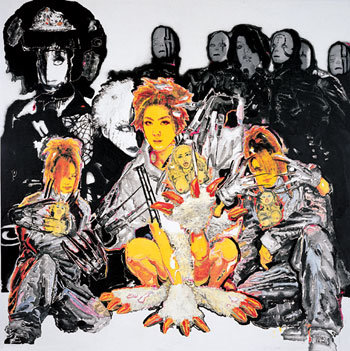Black and White Paintings Wear the Clothes of Today
Black and White Paintings Wear the Clothes of Today
Posted August. 16, 2005 03:09,

A massive display has begun that probes for modern ways to reinterpret and creatively develop traditional East Asian India ink paintings.
The main building of the Seoul Museum of Art opened a Korean-Chinese India ink Exhibit last week, sponsored by the Seoul Museum of Art and the Chinese Shenzhen Gallery in Guangdongsheng, Shenzhen, China. A substantial exhibit with works from 40 artists, it strives to banish the transcendental image of India ink paintings into something thats compatible with todays lifestyles. Its a chance to see the efforts of Korean and Chinese artists struggling with the recognition of tradition on one side and revolution on the other.
Shenzhen, China, is a place that has modernized and industrialized quickly due to frequent contact with Hong Kong. Rather than traditional Chinese techniques, many artists there have chosen to accept the Westernized trends of transmuted forms and the emphasized imagery of contemporary art.
Contemporary Chinese India ink paintings were born in the early 20th Century between the few learned masters in the art and the artists who aspired to create a revolution in India ink paintings. Artists like Gao Chian-fu, Xu Bei-hung, and Lin Phung-tiande cultivated the modern reinterpretation of India ink paintings through an understanding of figurative Western paintings.
After the 1950s, periodic pieces that reflected everyday life emerged, and due to the effect of a transformed societal reality and the influx of a new culture that began with the open-door policy in the 1980s, contemporary Chinese paintings were struck with reform.
The works of 20 artists such as Dong Xiaoming, Huang Yihan, Li Huasheng, Liang Quan, Liu Zijian, Wei Qingji, Shao Ge, Shi Guo, Tong Zhongtao, Wang Quan, Wang Tiande, Wu Yi, Yu Xiaogang, Zhang Hao, Zhang Tiande, and Zhou Jingxin will be on display. As if to reflect the Korean Wave, Huang Yihans Chinas New Man, in particular, has a drawing of the young Korean singer Moon hee-jun.
For the Korean display, artists who constituted various strata of Korean contemporary India ink paintings dating from the 1960s to the 1990s will display works according to four categories. Its a method all the more helpful for showing the historically significant aspects of modernization of paintings and identity exploration after the 1950s.
The first group is comprised of members of the "Mungnimhoe" Seo Se-ok, Shin Yeong-sang, Song Yeong-bang, and Jeong Tak-yeong, who expanded the abstract fields of 1960s Korean paintings. The second group includes artists who stressed the spirituality of India ink paintings in the 1980s and actively pursued the India ink paintings Movement Song Su-nam, Hong Seok-chang, Lee Cheol-ryang, and Moon Beong-seon. The third group has individual artists who steadily probed into India ink expressions, artists like Jeong Sang-ui, Song Su-ryeon, Kim Hee-yeong, O suk-hwan, Lee Min-ju, Lee Eun-suk, Lee Jong-mok, Cho Sun-ho, and Cho Hwan, and the fourth group revolves around young artists Park Byeong-chun, Yoo Geun-taek, and Jeong Kim-yong from the 1990s, who formed Dongpung.
A seminar will open on August 17 at 6:00 p.m. featuring the former manager of the National Museum of Contemporary Art of Korea, Oh Gwang-su, and the vice president of the Shenzhen Gallery at Yenshancheon discussing and debating on the history, future projects and forecasts for both countries contemporary India ink paintings. The exhibit runs through September 18. 02-2124-8800
Mun-Myung Huh angel@donga.com



![‘건강 지킴이’ 당근, 효능 높이는 섭취법[정세연의 음식처방]](https://dimg.donga.com/c/138/175/90/1/wps/NEWS/IMAGE/2026/01/18/133181291.1.jpg)



